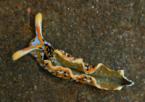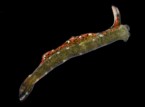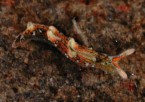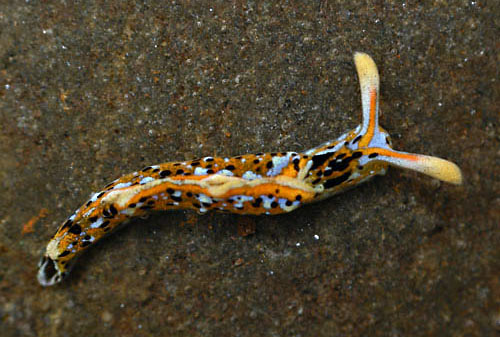_______________
Additional Photos

side

interior

underside

with papillae

erect chimneys
_______________
GALLERY

|
Elysia sp. #9

Maximum size: 8 mm.
Identification:
This
is
an
ornate
species
with
velvet-black
patches
(sometimes faintly
ocellate) on a dark olive background. The margins of the parapodia and
the rhinophore tips are covered with iridescent white to yellow flecks.
Iridescent
blue flecks cluster into patches on the sides of the parapodia and the
top of the head while iridescent orange flecks cover the sides of the
parapodia (clustering into a submarginal band) and form a Y-shaped band
on the rhinophores. The parapodia are short and held in three narrow,
pointed chimneys. There are sometimes a few white-tipped papillae on
their sides.
Natural history:
Elysia sp. # 9 is
a moderately rare species (only eight known animals) found in
rocky habitats. We've seen it in
moderately exposed to highly exposed areas at depths of < 1.5 m
(< 5
ft) and in tide pools.
Mature
animals are diurnally active. When crawling, it often stretches its
rhinophores forward and probes the substrate rhythmically in a manner
reminiscent of Flabellina bicolor.
A
5
mm
animal
laid
a
1.7
mm diameter egg
mass. It was orange and tightly coiled
with a narrow line of superficial, black-green pigment running along
the upper surface of the ribbon. Hatching occurred in about five days
in
the laboratory.
Distribution:
Maui and Niihau.
Taxonomic notes:
It was first
recorded
in
Hawaii
from
Maliko
Bay,
Maui
by
PF on May 6, 1999.
Photo: CP: 8
mm: Nakalele blowhole, Maui; March 21, 2011.
Observations and comments:
Note
1: ( )
|
|






